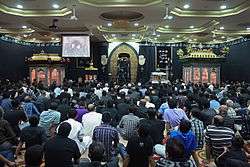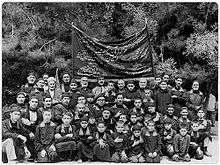Hussainiya
A ḥosayniya or hussainiya (Persian: حسینیه hoseyniye), also known as an ashurkhana, imambargah, or imambara, is a congregation hall for Twelver Shia Muslim commemoration ceremonies, especially those associated with the Mourning of Muharram.[1] Hussainiya is a multitude hall for the mourning of Muharram and other commemoration rituals of Shia that its name gets from Husayn ibn Ali, the grandson of Muhammad.[2]
| Ḥosayniya | |
|---|---|
 Hussainia in Dar es Salaam, Tanzania | |
| Arabic | حسينية (ḥusayniyya) مأتم (ma'tam) |
| Hindi | इमामबाड़ा (imāmbāṛā) आशुरख़ाना (āshurkhānā) |
| Bengali | ইমামবাড়া (imambaṛa) |
| Persian | حسینیه (ḥoseyniye) |
| Urdu | امامباڑا (imāmbāṛā) امامبارگاہ (imāmbārgāh) عاشور خانہ (āshurxānā) حسينيہ (huseyniya) |
| A series of articles on |
| Husayn ibn Ali |
|---|
 |
| Life |
|
| Remembrance |
|
| Perspectives |
Terminology
A hussainiya is different from a mosque.The name comes from Husayn ibn Ali, the third of the Twelve Imams and the grandson of the Islamic prophet Muhammad. Husayn was killed at the Battle of Karbala on 10 October 680 CE during the reign of Umayyad Caliph Yazid I. The Shia commemorate his martyrdom every year on Ashura, the 10th day of Muharram.[3] There are also other ceremonies which are held during the year in hussainiyas, including religious commemorations unrelated to Ashura.[4] and may not necessarily hold jumu'ah (Friday congregational prayer).
In South Asia, a hussainiya can also be referred to as an imambara, imambargah, or ashurkhana. In Afghanistan and Central Asia, it is also called a takyakhana. In Bahrain and the United Arab Emirates, it is called a ma'tam (Arabic: مأتم).
History
From the time of the Safavid was ruling in Iran, when Shia tended to hold the religious and mourning ceremonies, not only the passageways or the roofed places were used for the religious communities, even to make the Hoseynias and also Takyeh(s) became commonplace.[5] Any Hosseynia had some booths (or rooms) and arcades, both in large and small sizes. Also in many allays and streets, on the days near Ashoura, the religious people blackened the walls and the roofs and illuminated them, by the colorful lights... From the age of Zand, many bigger and vaster Takye(s) was made just to hold Tazia, where there was a stage by the height of one meter from the floor, to show the different senses of Tazieh.[6] Expense of the Hussainiya is provided by Charitable donations and endowments.[7][8]

Usage
Hussainiya was used during Muharram, Safar, and Ramadan for mourning, Rawda Khwani, Sineh Zani (a Customary form of mourning ceremony which shows their grief with chest-beating).[9] Also, Hussainiya is a place for accommodations of passengers[10] and pilgrims and feeding the poor.[1]
Notable hussainias

.jpg)

- Hosseinieh Azam Zanjan Mosque, in Zanjan, Iran
- Hussaini Dalan, in Dhaka, Bangladesh
- Prithimpasha Nawab Bari Imambara, in Kulaura, Bangladesh
- Bara Imambara, in Lucknow, India
- Chhota Imambara, in Lucknow, India
- Hooghly Imambara, in Hooghly (W.B.), India
- Nizamat Imambara, in Murshidabad, India
- Badshahi Ashurkhana, in Hyderabad, India
- Hosseiniyeh Ershad, in Tehran, Iran
- Hussaini Imambara Asim Raza Abdi, in 100/46, Colonel Ganj Kanpur,
- Imambara Ghufran Ma'ab, in Lucknow, India
- Imambargah Mir Vilayat Husain, in Karari Allahabad, India
- Azakhana Wazeer-un-Nisa, located in Amroha, India. The Azakhana was built in 1802 (1226 Hijri) with one Mosque.
- Imambargah Haveli Sa'daat, one of the oldest Imambargahs in Gujranwala, Pakistan. It was built by the Naqvi Sadat family, who migrated from Fatehgarh Churian, Punjab, India.
- Imambargah Bait Aal e Imran, in Kotla Arab Ali Khan, Gujrat, Pakistan. The site was donated by Choudhary Ghulam Hassan, a sunni by birth, and his wife in 1979.
See also
References
- Juan Eduardo Campo (1 January 2009). Encyclopedia of Islam. Infobase Publishing. pp. 318–. ISBN 978-1-4381-2696-8.
- Marafi, Najebah. The Intertwined Conflict: The Difference Between Culture and Religion. ISBN 978-1477128367.
- Hussainiya at Encyclopædia Iranica
- Hussainiahs and Takkiahs mashreghnews.ir
- Zoka, Yahya. History of Royal Citadel in Tehran and guide to Golestan Palace, (تاریخچه ساختمانهای ارگ سلطنتی تهران و راهنمای کاخ گلستان), vol 1. p. 283.
- The Iranian social history, (تاریخ اجتماعی ایران) written in persian, V 5, P 340
- Ansari Qomi. Iran's endowments in Iraq, ( موقوفات ايرانيان در عراق), vol 2. pp. 74–82.
- Ebrahimnegad Shirvani, Pourabbas, Mahbubeh-sadat, Ata. "The Role of Ashura rituals and post-Ashura days in spiritual health through promoting religious-oriented normal behavior: A practical model".
- "Tekyeh & Hussainiya". persiaadvisor.
- Kaempfer, Engelbert. Exotic Attractions in Persia, 1684-1688: Travels & Observations. Mage Publishers; 1st Hardcover edition (April 3, 2018). ISBN 978-1933823911.
| Wikimedia Commons has media related to Hussainia. |
